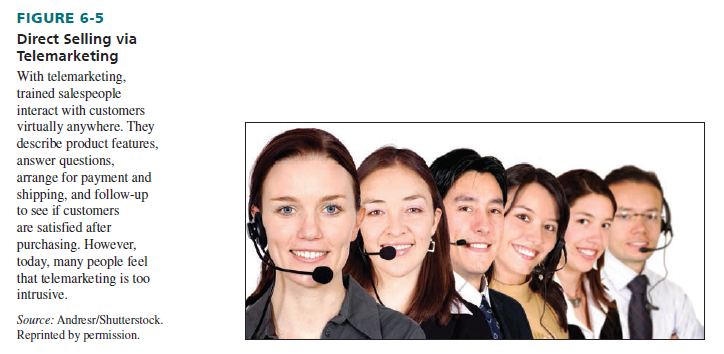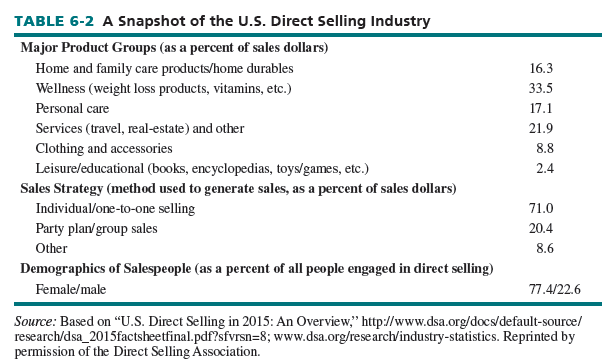Direct selling includes both personal contact with consumers in their homes (and other nonstore locations such as offices) and phone solicitations initiated by a retailer. See Figure 6-5. Cosmetics, jewelry, vitamins, household goods and services (such as carpet cleaning), vacuum cleaners, and magazines and newspapers are among the items sometimes sold in this way. The industry has $35 billion in annual U.S. sales and employs more than 18.2 million people (more than 90 percent of whom work part time). Annual foreign direct-selling revenues are an additional $185 billion, generated by more than 100 million salespeople.12 Table 6-2 shows a U.S. industry overview.


A direct-selling strategy emphasizes convenient shopping and a personal touch, and detailed demonstrations can be made. Consumers often relax more at home than in stores. They are also apt to be attentive and are not exposed to competing brands (as in stores). For some, such as older consumers and those with young children, in-store shopping is difficult due to limited mobility. For the retailer, direct selling has less overhead cost because stores and fixtures are not necessary. Despite its advantages, direct selling in the United States is growing slowly:
- Online transactions are easier and offer many more seller product options for shoppers.
- More women work, and they may not be interested in or available for at-home selling.
- The desire for full-time careers and job opportunities in other fields have reduced the pool of people interested in direct-selling jobs.
- A firm’s market coverage is limited by the size of its sales force.
- Sales productivity is low because the average transaction is small and most consumers are unreceptive—many will not open their doors to salespeople or talk to telemarketers.
- Sales force turnover is high because employees are often poorly supervised part-timers.
- To stimulate sales personnel, compensation is usually 25 to 50 percent of the revenues they generate. This means average to above-average prices.
- There are legal constraints due to deceptive and high-pressure sales tactics. One is the FTC’s Telemarketing Sales Rule (https://www.consumer.ftc.gov/articles/0198-telemarketing-sales- rule). It mandates that firms must disclose their identity and that the call’s purpose is selling.
- Because door-to-door has a poor image, the industry prefers the term direct selling.
Firms are reacting to these issues. Avon, for example, places greater emphasis on workplace sales, offers free training to sales personnel, rewards the best workers with better territories, pursues more global sales, and places cosmetics kiosks in shopping centers. Mary Kay hires community residents as salespeople and has a party atmosphere rather than a strict door-to-door approach; this requires networks of family, friends, and neighbors. And every major direct-selling firm has a Web site to supplement revenues.
Among the leading direct sellers are Avon and Mary Kay (cosmetics), Amway (household supplies), Tupperware (plastic containers), Shaklee (health products), Fuller Brush (small household products), and Kirby (vacuum cleaners). Some stores, such as J. C. Penney, also use direct selling. Penney’s decorator consultants sell a complete line of furnishings, not available in its stores, to consumers in their homes (http://goo.gl/MkpvjI).
Source: Barry Berman, Joel R Evans, Patrali Chatterjee (2017), Retail Management: A Strategic Approach, Pearson; 13th edition.

As I web-site possessor I believe the content material here is rattling magnificent , appreciate it for your efforts. You should keep it up forever! Best of luck.
After all, what a great site and informative posts, I will upload inbound link – bookmark this web site? Regards, Reader.